Connect With Us
Blogs
Blog
Babies and Flat Feet
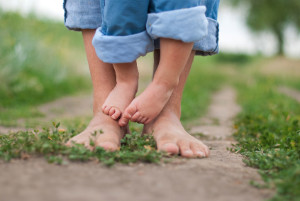 When babies are born, the feet have a considerable amount of fat. This allows them to be flexible, making it easy to stretch the ligaments that hold the bones together. Toddlers typically walk at approximately twelve months of age, and it is suggested that their first shoes are made of materials that can easily bend. Additionally, there needs to be adequate room for the toes to move freely in, which may help to prevent painful foot conditions. The majority of babies are born with flat feet, and the arch will generally develop at six years of age. If you notice your child's feet turn inward or outward, it is advised that you consult with a podiatrist who can help you to monitor this condition.
When babies are born, the feet have a considerable amount of fat. This allows them to be flexible, making it easy to stretch the ligaments that hold the bones together. Toddlers typically walk at approximately twelve months of age, and it is suggested that their first shoes are made of materials that can easily bend. Additionally, there needs to be adequate room for the toes to move freely in, which may help to prevent painful foot conditions. The majority of babies are born with flat feet, and the arch will generally develop at six years of age. If you notice your child's feet turn inward or outward, it is advised that you consult with a podiatrist who can help you to monitor this condition.
Making sure that your children maintain good foot health is very important as they grow. If you have any questions, contact Dr. Michael D. Garvin of Florida. Our doctor can provide the care you need to keep you pain-free and on your feet.
Keeping Children's Feet Healthy
Having healthy feet during childhood can help prevent medical problems later in life, namely in the back and legs. As children grow, their feet require different types of care. Here are some things to consider...
Although babies do not walk yet, it is still very important to take care of their feet.
Avoid putting tight shoes or socks on his or her feet.
Allow the baby to stretch and kick his or her feet to feel comfortable.
As a toddler, kids are now on the move and begin to develop differently. At this age, toddlers are getting a feel for walking, so don’t be alarmed if your toddler is unsteady or ‘walks funny’.
As your child gets older, it is important to teach them how to take care of their feet.
Show them proper hygiene to prevent infections such as fungus.
Be watchful for any pain or injury.
Have all injuries checked by a doctor as soon as possible.
Comfortable, protective shoes should always be worn, especially at play.
If you have any questions please feel free to contact our offices located in Port St. Lucie, FL . We offer the newest diagnostic and treatment technologies for all your foot and ankle needs.
Is My Foot Sprained or Broken?
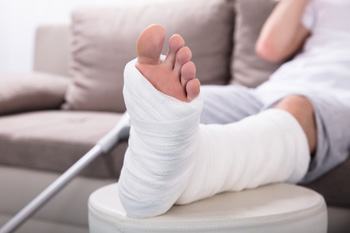 Sometimes it can be difficult to tell the difference between a sprain and a foot fracture. Both injuries have very similar symptoms, including pain, swelling, and bruising. A fracture will often be so painful that you may not be able to walk. Sprains can also make walking difficult, depending on the severity of the injury. At the time that you injure your foot, you may hear a noise. A popping sound can indicate a sprain, while a cracking sound can indicate a fracture. Treatments for the two conditions are different, so it is important to get a proper diagnosis. If you have injured your foot, it is suggested that you see a podiatrist as soon as possible.
Sometimes it can be difficult to tell the difference between a sprain and a foot fracture. Both injuries have very similar symptoms, including pain, swelling, and bruising. A fracture will often be so painful that you may not be able to walk. Sprains can also make walking difficult, depending on the severity of the injury. At the time that you injure your foot, you may hear a noise. A popping sound can indicate a sprain, while a cracking sound can indicate a fracture. Treatments for the two conditions are different, so it is important to get a proper diagnosis. If you have injured your foot, it is suggested that you see a podiatrist as soon as possible.
A broken foot requires immediate medical attention and treatment. If you need your feet checked, contact Dr. Michael D. Garvin from Florida. Our doctor can provide the care you need to keep you pain-free and on your feet.
Broken Foot Causes, Symptoms, and Treatment
A broken foot is caused by one of the bones in the foot typically breaking when bended, crushed, or stretched beyond its natural capabilities. Usually the location of the fracture indicates how the break occurred, whether it was through an object, fall, or any other type of injury.
Common Symptoms of Broken Feet:
- Bruising
- Pain
- Redness
- Swelling
- Blue in color
- Numbness
- Cold
- Misshapen
- Cuts
- Deformities
Those that suspect they have a broken foot shoot seek urgent medical attention where a medical professional could diagnose the severity.
Treatment for broken bones varies depending on the cause, severity and location. Some will require the use of splints, casts or crutches while others could even involve surgery to repair the broken bones. Personal care includes the use of ice and keeping the foot stabilized and elevated.
If you have any questions please feel free to contact our offices located in Port St. Lucie, FL . We offer the newest diagnostic and treatment technologies for all your foot and ankle needs.
Dealing With Hammertoe
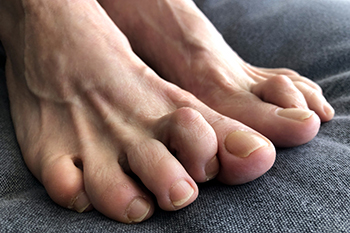
Hammertoe is a deformity that is usually found in the second toe. It is caused by an imbalance of the muscles, tendons, and ligaments that work together to make the toe straight. The result is that the middle joint of the toe raises up to form a peak, while the tip of the toe curls under. The type of shoes you wear, foot structure, and genetics all can contribute to the formation of a hammertoe. Women who wear high heels with pointy toes and children who wear shoes that are too short for their feet are more at risk of developing a hammertoe. Some people are simply born that way. Pain from a hammertoe occurs when the raised joint rubs against the inside of the top of the shoe. A corn or callus can develop, which may affect the gait and can increase pain in other parts of the foot and the body. A podiatrist can give you options for treating a hammertoe. Devices called hammertoe regulators can be custom fitted to help straighten the toe. Gentle exercises, such as picking up a towel with your toes can stretch and straighten the small muscles of the feet. In severe cases, surgery can be performed to permanently straighten the toe. For details on treatment options, please consult a podiatrist.
Hammertoe
Hammertoes can be a painful condition to live with. For more information, contact Dr. Michael D. Garvin from Florida. Our doctor will answer any of your foot- and ankle-related questions.
Hammertoe is a foot deformity that affects the joints of the second, third, fourth, or fifth toes of your feet. It is a painful foot condition in which these toes curl and arch up, which can often lead to pain when wearing footwear.
Symptoms
- Pain in the affected toes
- Development of corns or calluses due to friction
- Inflammation
- Redness
- Contracture of the toes
Causes
Genetics – People who are genetically predisposed to hammertoe are often more susceptible
Arthritis – Because arthritis affects the joints in your toes, further deformities stemming from arthritis can occur
Trauma – Direct trauma to the toes could potentially lead to hammertoe
Ill-fitting shoes – Undue pressure on the front of the toes from ill-fitting shoes can potentially lead to the development of hammertoe
Treatment
Orthotics – Custom made inserts can be used to help relieve pressure placed on the toes and therefore relieve some of the pain associated with it
Medications – Oral medications such as anti-inflammatories or NSAIDs could be used to treat the pain and inflammation hammertoes causes. Injections of corticosteroids are also sometimes used
Surgery – In more severe cases where the hammertoes have become more rigid, foot surgery is a potential option
If you have any questions please contact our offices located in Port St. Lucie, FL . We offer the newest diagnostic and treatment technologies for all your foot and ankle needs.
Common Foot Conditions Among Children
 In order to prevent any foot conditions from worsening, it’s important that you monitor your child’s walking pattern, and promptly seek professional help if the child is complaining about any foot pain. Some foot-related issues can be common among pediatric-aged patients. These issues can include pediatric flatfoot, Sever’s disease, ingrown toenails, and plantar warts. Pediatric flatfoot often doesn’t cause any symptoms; however, it can create an awkward walking or running pattern for the child. Ingrown toenails can be prevented by avoiding putting your child in shoes or socks that are too tight, as well as making sure that their toenails are trimmed properly. The nails should always be trimmed straight across and not too short. For more information on how to properly take care of your child’s feet, please consult with a podiatrist.
In order to prevent any foot conditions from worsening, it’s important that you monitor your child’s walking pattern, and promptly seek professional help if the child is complaining about any foot pain. Some foot-related issues can be common among pediatric-aged patients. These issues can include pediatric flatfoot, Sever’s disease, ingrown toenails, and plantar warts. Pediatric flatfoot often doesn’t cause any symptoms; however, it can create an awkward walking or running pattern for the child. Ingrown toenails can be prevented by avoiding putting your child in shoes or socks that are too tight, as well as making sure that their toenails are trimmed properly. The nails should always be trimmed straight across and not too short. For more information on how to properly take care of your child’s feet, please consult with a podiatrist.
Making sure that your children maintain good foot health is very important as they grow. If you have any questions, contact Dr. Michael D. Garvin of Florida. Our doctor can provide the care you need to keep you pain-free and on your feet.
Keeping Children's Feet Healthy
Having healthy feet during childhood can help prevent medical problems later in life, namely in the back and legs. As children grow, their feet require different types of care. Here are some things to consider...
Although babies do not walk yet, it is still very important to take care of their feet.
Avoid putting tight shoes or socks on his or her feet.
Allow the baby to stretch and kick his or her feet to feel comfortable.
As a toddler, kids are now on the move and begin to develop differently. At this age, toddlers are getting a feel for walking, so don’t be alarmed if your toddler is unsteady or ‘walks funny’.
As your child gets older, it is important to teach them how to take care of their feet.
Show them proper hygiene to prevent infections such as fungus.
Be watchful for any pain or injury.
Have all injuries checked by a doctor as soon as possible.
Comfortable, protective shoes should always be worn, especially at play.
If you have any questions please feel free to contact our offices located in Port St. Lucie, FL . We offer the newest diagnostic and treatment technologies for all your foot and ankle needs.
What Is a Hammertoe?
 The uncomfortable foot condition that is known as a hammertoe is considered to be a foot deformity. It can occur from genetic factors, or from wearing shoes that do not have adequate room for the toes to move freely in. The joints in the middle toes are typically affected, and can bend downward, which may resemble a hammer. Some patients have calluses that develop on top of the toes, and this may be a result of the toes rubbing against the top of the shoe. It may be beneficial to cease wearing pointed shoes such as high heels. Additionally, mild relief may be found when a protective pad is worn on the impacted toe. Severe hammertoes may cause pain and discomfort, and surgery may be a viable option to permanently straighten the toes. If you are afflicted with a hammertoe, it is suggested that you consult with a podiatrist as quickly as possible who can guide you toward the treatment that is best for you.
The uncomfortable foot condition that is known as a hammertoe is considered to be a foot deformity. It can occur from genetic factors, or from wearing shoes that do not have adequate room for the toes to move freely in. The joints in the middle toes are typically affected, and can bend downward, which may resemble a hammer. Some patients have calluses that develop on top of the toes, and this may be a result of the toes rubbing against the top of the shoe. It may be beneficial to cease wearing pointed shoes such as high heels. Additionally, mild relief may be found when a protective pad is worn on the impacted toe. Severe hammertoes may cause pain and discomfort, and surgery may be a viable option to permanently straighten the toes. If you are afflicted with a hammertoe, it is suggested that you consult with a podiatrist as quickly as possible who can guide you toward the treatment that is best for you.
Hammertoes can be a painful condition to live with. For more information, contact Dr. Michael D. Garvin of Florida. Our doctor will answer any of your foot- and ankle-related questions.
Hammertoe
Hammertoe is a foot deformity that occurs due to an imbalance in the muscles, tendons, or ligaments that normally hold the toe straight. It can be caused by the type of shoes you wear, your foot structure, trauma, and certain disease processes.
Symptoms
- Painful and/or difficult toe movement
- Swelling
- Joint stiffness
- Calluses/Corns
- Physical deformity
Risk Factors
- Age – The risk of hammertoe increases with age
- Sex – Women are more likely to have hammertoe compared to men
- Toe Length – You are more likely to develop hammertoe if your second toe is longer than your big toe
- Certain Diseases – Arthritis and diabetes may make you more likely to develop hammertoe
Treatment
If you have hammertoe, you should change into a more comfortable shoe that provides enough room for your toes. Exercises such as picking up marbles may strengthen and stretch your toe muscles. Nevertheless, it is important to seek assistance from a podiatrist in order to determine the severity of your hammertoe and see which treatment option will work best for you.
If you have any questions, please feel free to contact our offices located in Port St. Lucie, FL . We offer the newest diagnostic and treatment technologies for all your foot care needs.
Joint Replacement for Arthritis of the Big Toe
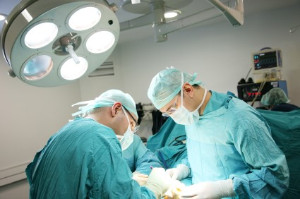
The base of the big toe is a common site for degenerative changes in the foot. Wear and tear and loss of elasticity in the cartilage cushioning the joint of the big toe can cause pain, swelling, and stiffness in the area. With the big toe moving up each time a step is taken, walking can be uncomfortable. Bone spurs can develop on the joint aggravating the pain already felt when walking with big toe arthritis. A bump, like a bunion or a callus, can also develop on the top of the foot with this affliction. When rest, medication, and exercise stop working, surgical options are considered. One such option is toe joint replacement. This is usually done among older sufferers with advanced arthritis. With toe joint replacement, an artificial joint made from ceramic, plastic, or metal, is surgically implanted after removing damaged parts of bones and cartilage in the big toe. This can be done under general or regional anesthesia and usually takes less than one hour. If you have advanced arthritis in your big toe and other less invasive treatments have not provided you enough relief to live life comfortably, talk to a podiatrist to see if you might be a good candidate for joint replacement surgery.
In certain cases, in which the patient suffers from extreme pain or damage in a joint, joint replacement surgery may be deemed useful. If you have constant pain in a foot joint, consult with Dr. Michael D. Garvin from Florida. Our doctor will assess your condition and provide you with quality foot and ankle treatment.
What Is Joint Replacement Surgery?
Over time, joints wear down; this can be exacerbated by diseases and conditions. Joint replacement surgery, also known as arthroplasty, is when a damaged joint is surgically removed and replaced with a prosthesis. Prostheses, which can be made of ceramic, plastic, or metal, act as joints in lieu of an actual joint. One of the most prevalent causes for joint replacement is arthritis.
Arthritis in the Foot
Arthritis can occur in any joint in the body, including in the feet. Common types of arthritis in the foot are osteoarthritis, rheumatoid arthritis, and gout. The big toe is usually where arthritis occurs in the foot; this is known as hallux rigidus.
Joint Replacement Surgery in the Foot
The most common form of joint replacement in the foot is a first metatarsophalangeal (MTP) joint placement. MTP joint replacement surgery is designed to treat hallux rigidus. Surgery is not intensive, and recovery occurs within one to two months after the procedure has been done. Overall, joint replacement surgery is a safe and effective way to treat pain in the joint of the foot.
If you have any questions, please feel free to contact our offices located in Port St. Lucie, FL . We offer the newest diagnostic and treatment technologies for all your foot care needs.
High Heels and Morton’s Neuroma
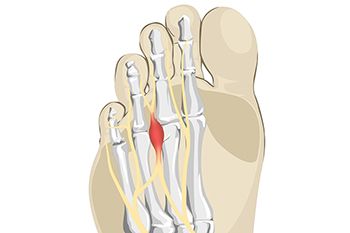
Morton’s neuroma is a foot condition that can develop in women who frequently wear high heels. This condition can result from having inadequate room for the toes to move freely in and can cause the nerve between the third and fourth toes to become compressed. Irritation and inflammation may accompany this, which can cause severe pain and discomfort. Patients who have Morton’s neuroma often say the sensation they feel is similar to having a pebble or marble in the shoe, in addition to numbness and tingling. Mild relief may also be found when soft insoles are worn, the feet are elevated, and shoes that are worn have a wide toe area. Existing medical conditions may contribute to Morton’s neuroma. These can include flat feet, bunions, and hammertoes. If you feel you may have this foot condition, it is advised that you speak to a podiatrist who can properly treat this ailment.
Morton’s neuroma is a very uncomfortable condition to live with. If you think you have Morton’s neuroma, contact Dr. Michael D. Garvin of Florida. Our doctor will attend to all of your foot care needs and answer any of your related questions.
Morton’s Neuroma
Morton's neuroma is a painful foot condition that commonly affects the areas between the second and third or third and fourth toe, although other areas of the foot are also susceptible. Morton’s neuroma is caused by an inflamed nerve in the foot that is being squeezed and aggravated by surrounding bones.
What Increases the Chances of Having Morton’s Neuroma?
- Ill-fitting high heels or shoes that add pressure to the toe or foot
- Jogging, running or any sport that involves constant impact to the foot
- Flat feet, bunions, and any other foot deformities
Morton’s neuroma is a very treatable condition. Orthotics and shoe inserts can often be used to alleviate the pain on the forefront of the feet. In more severe cases, corticosteroids can also be prescribed. In order to figure out the best treatment for your neuroma, it’s recommended to seek the care of a podiatrist who can diagnose your condition and provide different treatment options.
If you have any questions, please feel free to contact our offices located in Port St. Lucie, FL . We offer the newest diagnostic and treatment technologies for all your foot care needs.
The Progression of PAD
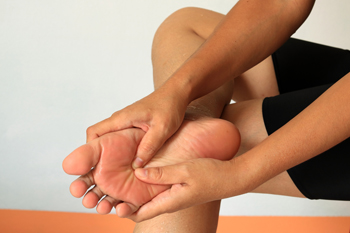 Peripheral artery disease (PAD) is a condition that causes reduced blood flow in the lower limbs. PAD is fairly common, particularly in older people, and is caused by a buildup of plaque along the walls of the arteries. The plaque makes the arteries narrow and harden, which makes it harder for blood to circulate to the lower limbs and provide the muscles with oxygen and nutrients. This leads to symptoms that include pain, achiness, fatigue, burning, muscle cramps, and overall discomfort in the feet and ankles. At first, these symptoms may just appear when you do more strenuous physical activities like walking uphill, walking for longer distances, or running. Eventually, however, the symptoms may worsen and appear after only a little bit of activity. You may also begin to experience numbness in your lower limbs when you are at rest. If you have symptoms of PAD, please seek the care of a podiatrist.
Peripheral artery disease (PAD) is a condition that causes reduced blood flow in the lower limbs. PAD is fairly common, particularly in older people, and is caused by a buildup of plaque along the walls of the arteries. The plaque makes the arteries narrow and harden, which makes it harder for blood to circulate to the lower limbs and provide the muscles with oxygen and nutrients. This leads to symptoms that include pain, achiness, fatigue, burning, muscle cramps, and overall discomfort in the feet and ankles. At first, these symptoms may just appear when you do more strenuous physical activities like walking uphill, walking for longer distances, or running. Eventually, however, the symptoms may worsen and appear after only a little bit of activity. You may also begin to experience numbness in your lower limbs when you are at rest. If you have symptoms of PAD, please seek the care of a podiatrist.
Peripheral artery disease can pose a serious risk to your health. It can increase the risk of stroke and heart attack. If you have symptoms of peripheral artery disease, consult with Dr. Michael D. Garvin from Florida. Our doctor will assess your condition and provide you with quality foot and ankle treatment.
Peripheral artery disease (PAD) is when arteries are constricted due to plaque (fatty deposits) build-up. This results in less blood flow to the legs and other extremities. The main cause of PAD is atherosclerosis, in which plaque builds up in the arteries.
Symptoms
Symptoms of PAD include:
- Claudication (leg pain from walking)
- Numbness in legs
- Decrease in growth of leg hair and toenails
- Paleness of the skin
- Erectile dysfunction
- Sores and wounds on legs and feet that won’t heal
- Coldness in one leg
It is important to note that a majority of individuals never show any symptoms of PAD.
Diagnosis
While PAD occurs in the legs and arteries, Podiatrists can diagnose PAD. Podiatrists utilize a test called an ankle-brachial index (ABI). An ABI test compares blood pressure in your arm to you ankle to see if any abnormality occurs. Ultrasound and imaging devices may also be used.
Treatment
Fortunately, lifestyle changes such as maintaining a healthy diet, exercising, managing cholesterol and blood sugar levels, and quitting smoking, can all treat PAD. Medications that prevent clots from occurring can be prescribed. Finally, in some cases, surgery may be recommended.
If you have any questions, please feel free to contact our offices located in Port St. Lucie, FL . We offer the newest diagnostic and treatment technologies for all your foot care needs.
Bunion Exercises
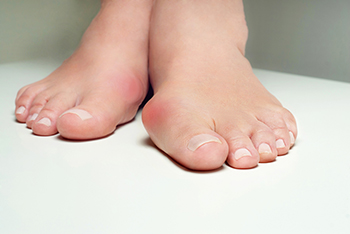 A bunion is described as a bony protrusion that forms on the side of the big toe. Many patients experience pain and discomfort from this ailment, and it may gradually worsen. It can happen as a result of genetic factors, or from wearing shoes that do not have adequate room for the toes to move freely in. The muscles can become weakened, and it is beneficial to perform specific foot stretches that may help to strengthen the affected area and overall foot. A foot scrunch helps to improve dexterity when performed regularly. This is done by placing a towel on the floor, and lifting it up with your foot. Toe yoga helps to improve mobility in the toes, which may positively affect general balance in the body. If you have developed a bunion, it is strongly suggested that you speak with a podiatrist who can offer you additional exercise and treatment options that are right for you.
A bunion is described as a bony protrusion that forms on the side of the big toe. Many patients experience pain and discomfort from this ailment, and it may gradually worsen. It can happen as a result of genetic factors, or from wearing shoes that do not have adequate room for the toes to move freely in. The muscles can become weakened, and it is beneficial to perform specific foot stretches that may help to strengthen the affected area and overall foot. A foot scrunch helps to improve dexterity when performed regularly. This is done by placing a towel on the floor, and lifting it up with your foot. Toe yoga helps to improve mobility in the toes, which may positively affect general balance in the body. If you have developed a bunion, it is strongly suggested that you speak with a podiatrist who can offer you additional exercise and treatment options that are right for you.
If you are suffering from bunion pain, contact Dr. Michael D. Garvin of Florida. Our doctor can provide the care you need to keep you pain-free and on your feet.
What Is a Bunion?
Bunions are painful bony bumps that usually develop on the inside of the foot at the joint of the big toe. As the deformity increases over time, it may become painful to walk and wear shoes. Women are more likely to exacerbate existing bunions since they often wear tight, narrow shoes that shift their toes together. Bunion pain can be relieved by wearing wider shoes with enough room for the toes.
Causes
- Genetics – some people inherit feet that are more prone to bunion development
- Inflammatory Conditions - rheumatoid arthritis and polio may cause bunion development
Symptoms
- Redness and inflammation
- Pain and tenderness
- Callus or corns on the bump
- Restricted motion in the big toe
In order to diagnose your bunion, your podiatrist may ask about your medical history, symptoms, and general health. Your doctor might also order an x-ray to take a closer look at your feet. Nonsurgical treatment options include orthotics, padding, icing, changes in footwear, and medication. If nonsurgical treatments don’t alleviate your bunion pain, surgery may be necessary.
If you have any questions, please feel free to contact our offices located in Port St. Lucie, FL . We offer the newest diagnostic and treatment technologies for all your foot care needs.
More...
A Small Bony Growth May Indicate a Heel Spur
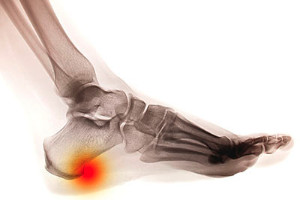
Stress and tension on the heels may result in a heel spur forming. It is defined as a small bony growth that forms on the bottom of the heel and is the body's natural defense against heel damage. The pain from a heel spur can be uncomfortable and can travel to the bottom of the foot where the plantar fascia lies. This is the band of tissue that connects the heel to the toes, and plantar fasciitis may gradually develop if inflammation occurs. A heel spur may be misdiagnosed as plantar fasciitis because it affects the heel. A proper evaluation is needed to differentiate between the two conditions, and this consists of having an X-ray taken. The heel spur is often noticeable in the X-ray and is done so the proper treatment can begin. Heel spurs can develop for various reasons, including wearing shoes that do not fit correctly, being overweight, or if the muscles in the back of the leg are tight. Mild relief may be found when comfortable shoes are worn, in addition to performing specific stretches that can ease heel pain. If you have a heel spur, please confer with a podiatrist as quickly as possible who can determine what the best treatment is for you.
Heel spurs can be incredibly painful and sometimes may make you unable to participate in physical activities. To get medical care for your heel spurs, contact Dr. Michael D. Garvin from Florida. Our doctor will do everything possible to treat your condition.
Heels Spurs
Heel spurs are formed by calcium deposits on the back of the foot where the heel is. This can also be caused by small fragments of bone breaking off one section of the foot, attaching onto the back of the foot. Heel spurs can also be bone growth on the back of the foot and may grow in the direction of the arch of the foot.
Older individuals usually suffer from heel spurs and pain sometimes intensifies with age. One of the main condition's spurs are related to is plantar fasciitis.
Pain
The pain associated with spurs is often because of weight placed on the feet. When someone is walking, their entire weight is concentrated on the feet. Bone spurs then have the tendency to affect other bones and tissues around the foot. As the pain continues, the feet will become tender and sensitive over time.
Treatments
There are many ways to treat heel spurs. If one is suffering from heel spurs in conjunction with pain, there are several methods for healing. Medication, surgery, and herbal care are some options.
If you have any questions feel free to contact our offices located in Port St. Lucie, FL . We offer the latest in diagnostic and treatment technology to meet your needs.
Working on the Feet While Pregnant
 Pregnancy can create additional pressure on the feet, making certain everyday activities and responsibilities difficult for women. Women who work desk jobs should ensure that they’re sitting in chairs that offer optimal support, while women who spend a majority of their time standing should occasionally elevate their feet using a foot rest. Wearing comfortable shoes is also a must and should never be overlooked. Elevating the feet can also help pregnant women in managing edema, as the feet often swell during pregnancy.
Pregnancy can create additional pressure on the feet, making certain everyday activities and responsibilities difficult for women. Women who work desk jobs should ensure that they’re sitting in chairs that offer optimal support, while women who spend a majority of their time standing should occasionally elevate their feet using a foot rest. Wearing comfortable shoes is also a must and should never be overlooked. Elevating the feet can also help pregnant women in managing edema, as the feet often swell during pregnancy.
Pregnant women with swollen feet can be treated with a variety of different methods that are readily available. For more information about other cures for swollen feet during pregnancy, consult with Dr. Michael D. Garvin from Florida. Our doctor will attend to all of your foot and ankle needs.
What Foot Problems Can Arise During Pregnancy?
One problem that can occur is overpronation, which occurs when the arch of the foot flattens and tends to roll inward. This can cause pain and discomfort in your heels while you’re walking or even just standing up, trying to support your baby.
Another problem is edema, or swelling in the extremities. This often affects the feet during pregnancy but tends to occur in the later stages.
How Can I Keep My Feet Healthy During Pregnancy?
- Wearing orthotics can provide extra support for the feet and help distribute weight evenly
- Minimize the amount of time spent walking barefoot
- Wear shoes with good arch support
- Wear shoes that allow for good circulation to the feet
- Elevate feet if you experience swelling
- Massage your feet
- Get regular, light exercise, such as walking, to promote blood circulation to the feet
If you have any questions please feel free to contact our offices located in Port St. Lucie, FL . We offer the newest diagnostic and treatment technologies for all your foot and ankle needs.
What is Hammertoe and Mallet Toe?
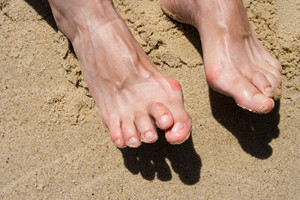 An imbalance in either the muscles, ligaments, and tendons in the foot that keep the toes straight can cause hammertoe or mallet toe. Causes of this imbalance can stem from improperly-fitted shoes, trauma, and even foot structure. An abnormal bend in the middle joint of a toe is called hammertoe. When the joint nearest to the toenail is affected, this condition is called mallet toe. Poorly-fitted shoes can result in the toes becoming compressed which can result in the condition. Simply wearing properly-fitted footwear may cause the toes to become uncompressed and restore balance in the foot. However, surgery may be needed if the issue stems from trauma or foot structure, and if symptoms become more severe or do not go away.
An imbalance in either the muscles, ligaments, and tendons in the foot that keep the toes straight can cause hammertoe or mallet toe. Causes of this imbalance can stem from improperly-fitted shoes, trauma, and even foot structure. An abnormal bend in the middle joint of a toe is called hammertoe. When the joint nearest to the toenail is affected, this condition is called mallet toe. Poorly-fitted shoes can result in the toes becoming compressed which can result in the condition. Simply wearing properly-fitted footwear may cause the toes to become uncompressed and restore balance in the foot. However, surgery may be needed if the issue stems from trauma or foot structure, and if symptoms become more severe or do not go away.
Hammertoe
Hammertoes can be a painful condition to live with. For more information, contact Dr. Michael D. Garvin from Florida. Our doctor will answer any of your foot- and ankle-related questions.
Hammertoe is a foot deformity that affects the joints of the second, third, fourth, or fifth toes of your feet. It is a painful foot condition in which these toes curl and arch up, which can often lead to pain when wearing footwear.
Symptoms
- Pain in the affected toes
- Development of corns or calluses due to friction
- Inflammation
- Redness
- Contracture of the toes
Causes
Genetics – People who are genetically predisposed to hammertoe are often more susceptible
Arthritis – Because arthritis affects the joints in your toes, further deformities stemming from arthritis can occur
Trauma – Direct trauma to the toes could potentially lead to hammertoe
Ill-fitting shoes – Undue pressure on the front of the toes from ill-fitting shoes can potentially lead to the development of hammertoe
Treatment
Orthotics – Custom made inserts can be used to help relieve pressure placed on the toes and therefore relieve some of the pain associated with it
Medications – Oral medications such as anti-inflammatories or NSAIDs could be used to treat the pain and inflammation hammertoes causes. Injections of corticosteroids are also sometimes used
Surgery – In more severe cases where the hammertoes have become more rigid, foot surgery is a potential option
If you have any questions please contact our offices located in Port St. Lucie, FL . We offer the newest diagnostic and treatment technologies for all your foot and ankle needs.
Treating Plantar Fasciitis
 Plantar fasciitis is a painful foot condition that is typically felt after taking your first steps in the morning. The symptoms tend to go away when you sit down, but the sharp pains will pop up again when you walk around. Some risk factors for the condition include standing for a long period of time, increased body weight, and age. The best way to alleviate plantar fasciitis pain is to treat the condition in its early stages instead of waiting for it to progress. You should contact your podiatrist immediately if you suspect you may have plantar fasciitis in order to get rid of any pain you are experiencing.
Plantar fasciitis is a painful foot condition that is typically felt after taking your first steps in the morning. The symptoms tend to go away when you sit down, but the sharp pains will pop up again when you walk around. Some risk factors for the condition include standing for a long period of time, increased body weight, and age. The best way to alleviate plantar fasciitis pain is to treat the condition in its early stages instead of waiting for it to progress. You should contact your podiatrist immediately if you suspect you may have plantar fasciitis in order to get rid of any pain you are experiencing.
Plantar fasciitis can be very painful and inconvenient. If you are experiencing heel pain or symptoms of plantar fasciitis, contact Dr. Michael D. Garvin from Florida. Our doctor can provide the care you need to keep you pain-free and on your feet.
What Is Plantar Fasciitis?
Plantar fasciitis is the inflammation of the thick band of tissue that runs along the bottom of your foot, known as the plantar fascia, and causes mild to severe heel pain.
What Causes Plantar Fasciitis?
- Excessive running
- Non-supportive shoes
- Overpronation
- Repeated stretching and tearing of the plantar fascia
How Can It Be Treated?
- Conservative measures – anti-inflammatories, ice packs, stretching exercises, physical therapy, orthotic devices
- Shockwave therapy – sound waves are sent to the affected area to facilitate healing and are usually used for chronic cases of plantar fasciitis
- Surgery – usually only used as a last resort when all else fails. The plantar fascia can be surgically detached from the heel
While very treatable, plantar fasciitis is definitely not something that should be ignored. Especially in severe cases, speaking to your doctor right away is highly recommended to avoid complications and severe heel pain. Your podiatrist can work with you to provide the appropriate treatment options tailored to your condition.
If you have any questions please feel free to contact our offices located in Port St. Lucie, FL . We offer the newest diagnostic and treatment technologies for all your foot and ankle needs.

